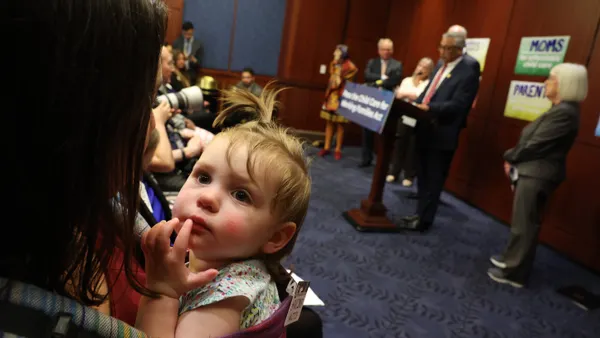Autumn is upon us. The air is cooler. The leaves are changing colors. Pumpkin versions of all of your favorite foods are in supermarkets.
And for thousands of benefits administrators, it’s open enrollment season — the annual workplace ritual in which millions of employees select their 2018 health and voluntary benefits. HR professionals are certainly no stranger to the routine, but its significance bears repeating: Billions of dollars worth of decisions happen in very short timeframes, and those decisions have a major influence not only on an employee’s health and well-being over the course of the year but also their satisfaction with their jobs. Benefits professionals take their role very seriously in delivering on open enrollment, and their long hours and work weeks show it.
In dozens of conversations with benefits administrators in a multitude of industries across the country since the beginning of the year, I have both shared and heard about the latest benefits trends, the state of healthcare reform and its impacts on employer-based coverage, and the many intersections of their needs and new benefits and HR technologies.
But most of all, we’ve talked about open enrollment — both the challenges it presents and the strategies that can help turn those challenges into opportunities. As you’d expect, some challenges play much more prominently in certain regions or industries (e.g. HMO’s in California, retirees in the public sector, or younger workforces in retail and hospitality). But there is surprising similarity across the board on open enrollment priorities and strategies. Everyone is trying to solve for the same basic goal: creating happy, healthy (physically and financially) employees without breaking the benefits bank.
Here are the top five priorities benefits administrators have shared with me as they’ve planned for open enrollment 2018 and beyond.
Controlling costs
It shouldn’t come as a surprise that rising costs would make the list. What is surprising is that the perspective I have heard from benefits administrators regarding cost is how powerless they feel in regards to controlling them. Small and large companies, whether fully insured or self-insured, feel at the mercy of their carriers and administrators. “We just wait for them to tell us how much our costs will go up and then try to assess the damage,” an administrator for a utility services provider told me.
The increasing availability of claims data analytics tools can be very useful in this challenge. One benefits administrator in the southeast went self-funded and was able to lower their costs in a single year by simply seeing where their high prescription drug and emergency services claims were and promoting cheaper alternatives to their employees.
Driving administrative efficiency
“I have become a project manager,” said a benefits director from the northeast, referring to the various annual tasks involved in open enrollment preparation and execution, from working with consultants and carriers on plan designs, working with brokers and carriers on types of benefits, and working with technology vendors and TPA’s on enrollment tools and data integrations, to name just three. And don’t get them started on compliance and healthcare reform. “What’s hitting me the most right now is just the enormity of the job,” said a manager from an oil and gas company in the west.
A great many administrators also indicated that they were a “department of one” and were being spread increasingly thin from all of the demands being placed on them. What they felt would help them through open enrollment 2018 and beyond was anything that drove more efficiency: brokers that also provide administrative support, automated enrollment tools that provide both the enrollment experience and the data integrations with payroll and benefits providers, and ben-admin support and services at a reasonable cost (see above). HR professionals get into the business because they love people. Addressing the administrative challenges of open enrollment opens them up to connect with what they love the most about their jobs.
Reaching diverse workforces
Millennials now make up the largest generation of the workforce. Their expectations of benefits vary widely from Gen Xers, Baby Boomers and even the emerging Gen Z. But every generation expects a more streamlined process. “I can’t put a paper application in front of my employees,” said an administrator with a technology company in the Northwest. “They’ll revolt."
Benefits professionals are adopting numerous tools to help bridge the gap between old ways of administering benefits and new expectations of those who’ve been on the internet almost since birth. Foremost among them are mobile experiences, which are not only helping employers reach younger generations of workers but they’re also connecting with less traditional workers of all generations. A benefits manager with a large national retailer said they wouldn’t consider a vendor that didn’t have a mobile strategy. And an administrator for a transportation company in the Midwest told me that 95% of their workers are truckers of all ages who use their smartphones for everything. Mobile is how benefits administrators need to reach them.
Personalizing benefits offerings
With generational shifts in workforces comes shifts in the makeup of benefits offerings. Whereas it wasn’t uncommon a generation ago for employees to have only two to four insurance-based benefits offered to them (medical, dental, short-term disability, voluntary life), numerous studies have shown that number has steadily risen over the past 10 years. In many cases, employers are now offering a dozen or more benefits types to employees, including things like pet insurance, identity theft protection and non-retirement financial benefits (student loan debt help, short-term loans, etc.). These are the building blocks, along with a digital enrollment platform, for personalization. Employees elect the benefits they want from a much broader selection, which benefits administrators hope drive higher employee satisfaction and retention.
However, personalization takes effort. “What always bugs me is that the voluntary benefits providers say ‘There’s no extra effort on your part.’ I’m like ‘Really? You have to get data from my system, you have to get paid from my payroll deductions.’ It’s just adding work,” said a benefits manager at a nonprofit organization in the Mid-Atlantic. Overcoming these challenges takes more than just a broker. It takes technology and benadmin services providers that can address the numerous administrative challenges.
Communicating with employees
After spending millions of dollars and/or countless hours on personalized, mobile, efficient open enrollments for employees, benefits and HR administrators want to ensure that employees understand everything that’s being presented to them. Doing so requires frequent and varied communication methods.
How do you execute on a communication plan with limited benefits and HR resources? “I use my broker for everything,” said an administrator for a manufacturing company in the west. Others cited getting Corporate Communications on board to help provide marketing support, or third-party consultants that specialize in benefits. Still others said the key to disseminating information that will get seen and understood is finding your company mavens — people who know how to talk about benefits and want to share with their fellow employees. If an administrator can’t find mavens, managers may be the next best thing.
They also stressed casting a wide net to help reach different generations and personality types in different ways. Videos are always popular and help drive consistency. The midwestern transportation company’s benefits manager noted their use of social media, especially Facebook. “It’s almost always the wives of our drivers who are making the decisions, so we started talking about [open enrollment ] on Facebook and when they saw it on their husbands’ feeds, they knew it was time to start planning.”
When you step back and look at these priorities with an understanding of all they entail, you can easily see how benefits administrators may feel overwhelmed. But the greatest quality I’ve encountered among benefits administrators over the years is their commitment to their people. They want open enrollment to be a success, and they will gravitate toward those that help them toward that success. Even though many administrators are an army of one, they know it takes a village to get through open enrollment . Here’s wishing them all great success in 2018 and beyond.
Editor's Note: Shandon Fowler is the founder and principal of Four8 Insights, which provides strategic direction on healthcare, benefits and HR technology to the whole benefits ecosystem. He was previously senior director of Product Strategy for Benefitfocus. You can contact him at [email protected].




















